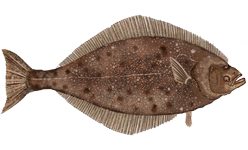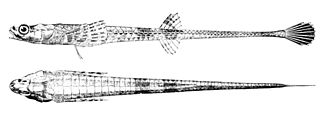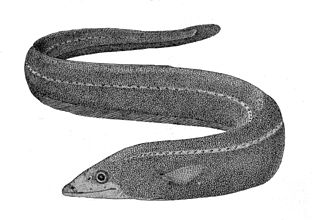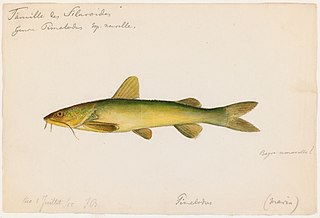
Flounders are a group of flatfish species. They are demersal fish, found at the bottom of oceans around the world; some species will also enter estuaries.

Halibut is the common name for three flatfish in the genera Hippoglossus and Reinhardtius from the family of right-eye flounders and, in some regions, and less commonly, other species of large flatfish.

Pleuronectidae, also known as righteye flounders, are a family of flounders. They are called "righteye flounders" because most species lie on the sea bottom on their left sides, with both eyes on their right sides. The Paralichthyidae are the opposite, with their eyes on the left side. A small number of species in Pleuronectidae can also have their eyes on the left side, notably the members of the genus Platichthys.

Hippoglossus stenolepis, the Pacific halibut, is a species of righteye flounder. This very large species of flatfish is native to the North Pacific and is fished by commercial fisheries, sport fishers, and subsistence fishers.

The Atlantic halibut is a flatfish of the family Pleuronectidae. They are demersal fish living on or near sand, gravel or clay bottoms at depths of between 50 and 2,000 m. The halibut is among the largest teleost (bony) fish in the world, and is a threatened species due to a slow rate of growth and overfishing. Halibut are strong swimmers and are able to migrate long distances. Halibut size is not age-specific, but rather tends to follow a cycle related to halibut abundance.

Aspidophoroides is a genus of poachers native to the northern Pacific and Atlantic oceans.

The Bean's sawtooth eel is an eel in the family Nemichthyidae. It was described by Theodore Gill and John Adam Ryder in 1883. It is a marine, deep water-dwelling eel which is known from throughout the Atlantic Ocean, the Indian Ocean, and the Western Pacific Ocean, including Iceland, South Africa, Réunion, and Australia. It dwells at a depth range of 0–5998 metres, and leads a solitary lifestyle. It migrates vertically at night. Males can reach a maximum total length of 78-80 centimetres, making it the largest sawtooth eel.

The shortdorsal cutthroat eel is an eel in the family Synaphobranchidae. It was described by Albert Günther in 1887. It is a marine, deep water-dwelling eel which is known from the Indo-Pacific and western central Atlantic Ocean, including Zanzibar, Maldives, Australia, Japan, Suriname, and the Gulf of Mexico. It dwells at a depth range of 900 to 3,000 metres, most often between 1,000 to 2,500 metres, and leads a benthic lifestyle, inhabiting the continental slope. Males can reach a maximum total length of 111 centimetres (44 in).
The Kaup's arrowtooth eel is an eel in the family Synaphobranchidae. It was described by James Yate Johnson in 1862. It is a marine, deep water-dwelling eel which is known from the Indo-Western Pacific and eastern and western Atlantic Ocean, including the Faroe Islands, Iceland, Cape Verde, the Western Sahara, Nigeria, Namibia, South Africa, Greenland, France, Saint Pierre and Miquelon, the United Kingdom, Ireland, the Philippines, Portugal, Spain, the Bahamas, Brazil, Canada, Cuba, Japan, Australia, Mauritania, Morocco, and Hawaii. It dwells at a depth range of 120 to 4,800 metres, most often between 400 to 2,200 metres, and inhabits the upper abyssal zone on the continental slope. It is intolerant of the temperatures of higher waters. Males can reach a maximum total length of 100 centimetres (39 in).
Agonopsis chiloensis, the snailfish, is a fish in the family Agonidae. It was described by Leonard Jenyns in 1840. It is a subtropical, marine fish which is known from the southeastern Pacific and southwestern Atlantic Ocean, including Chile, Patagonia, and Argentina. It is known to dwell at a depth range of 3–400 metres. Males can reach a maximum standard length of 12.5 centimetres.
The sawback poacher is a species of fish in the family Agonidae. It was described by Charles Henry Gilbert in 1896, originally under the genus Odontopyxis. It is a marine, temperate water-dwelling fish which is known from the northern Pacific Ocean, including Japan, the Gulf of Anadyr, the Bering Sea, the Aleutian chain, and British Columbia, Canada. It dwells at a depth range of 18 to 975 metres, and inhabits soft sediments. Males can reach a maximum total length of 27 centimetres (11 in).
the smooth alligatorfish is a fish in the family Agonidae. It was described by Albert Günther in 1860. It is a marine fish which dwells in temperate waters, and is known from the northern Pacific Ocean, including California, USA, and possibly Korea. It dwells at a depth range of 8–102 metres, usually around rocks. Males can reach a maximum total length of 15 centimetres.
The Arctic alligatorfish is a fish in the family Agonidae. It was described by C.F. Lütken in 1877. It is a marine and brackish-water dwelling fish which is known from the Arctic, the northwestern Atlantic and northwestern and northeastern Pacific Ocean, including Canada, Greenland, Siberia, the Barents Sea, the White Sea, the Kara Sea, the Chukchi Sea, the Bering Sea, the Bering Strait, and the Anadyr Gulf. It dwells at a depth range of 7–520 metres, in salinities of 30-35 ppt, and leads a benthic lifestyle, inhabiting sand and mud bottoms. It mostly lives in temperatures below 0 °C, but on rare occasions has been found in temperatures of 2-3 °C. Males can reach a maximum total length of 8.6 centimetres.
The blackfin poacher is a fish in the family Agonidae. It was described by Charles Henry Gilbert in 1890. It is a marine, boreal water-dwelling fish which is known from the northern Pacific Ocean, including Komandorski Island and Avachin Bay in Russia, St. Mathew Island in the Bering Sea, and Eureka, California, USA. It dwells at a depth range of 18–1290 metres, most often at around 400–700 m, and inhabits soft bottoms. It is known to live for a maximum of 9 years. Males can reach a maximum total length of 24.2 centimetres, but more commonly reach a TL of 20 cm.
The bigeye poacher is a fish in the family Agonidae. It was described by Charles Henry Gilbert in 1890. It is a marine, subtropical fish which is known from the Gulf of Alaska to southern California, USA, in the northern Pacific Ocean. It dwells at a depth range of 110–910 metres, and inhabits soft bottoms. Males can reach a maximum total length of 23 centimetres.

The fourhorn poacher is a fish in the family Agonidae. It was described by Achille Valenciennes in 1829, originally under the genus Aspidophorus. It is a marine, temperate water-dwelling fish which is known from the northern Pacific Ocean, including the Sea of Okhotsk, the Sea of Japan, the Bering Sea, the Kuril Islands, and Washington, USA. It is non-migratory, and dwells at a depth range of 0 to 452 metres, most often at around 100 to 150 metres. It inhabits sediments of sand and gravel. Males can reach a maximum total length of 12 centimetres (4.7 in), but more commonly reach a TL of 10 centimetres (3.9 in). The maximum recorded weight is 24 grams (0.053 lb), and the maximum recorded age is 7 years.

The Madamango sea catfish, also known as the Raspfin sea catfish or the Spring cuirass, is a species of catfish in the family Ariidae. It was described by Louis Agassiz in 1829. It is a tropical, marine and brackish water-dwelling catfish which occurs between Colombia and Brazil. It inhabits a depth range between 1 to 50 m. It reaches a maximum total length of 30 cm (12 in), more commonly reaching a TL of 20 cm (7.9 in).

The Pemecou sea catfish, also known as the flapnose sea catfish, the mud cuirass, or the gillbacker, is a species of catfish in the family Ariidae. It was described by Marcus Elieser Bloch in 1794, originally under the genus Silurus. It inhabits marine, brackish and freshwaters in Brazil, Guyana, French Guiana, Colombia, Suriname, Venezuela, and Trinidad and Tobago. It dwells at a depth range of 1 to 5 m. It reaches a maximum total length of 94.2 cm (37.1 in), while males more commonly reach a TL of 30 cm (12 in) and females reach a TL of 62.5 cm (24.6 in). It reaches a maximum weight of 1.5 kg (3.3 lb).
Gymnachirus nudus, the naked sole, also known as the flabby sole, is a species of sole in the family Achiridae. It was described by Johann Jakob Kaup in 1858. It is known from throughout the western Atlantic. It dwells on soft bottoms at a depth range of 2 to 100 m. It reaches a maximum total length of 15 cm (5.9 in), more commonly reaching a TL of 12 cm (4.7 in).











